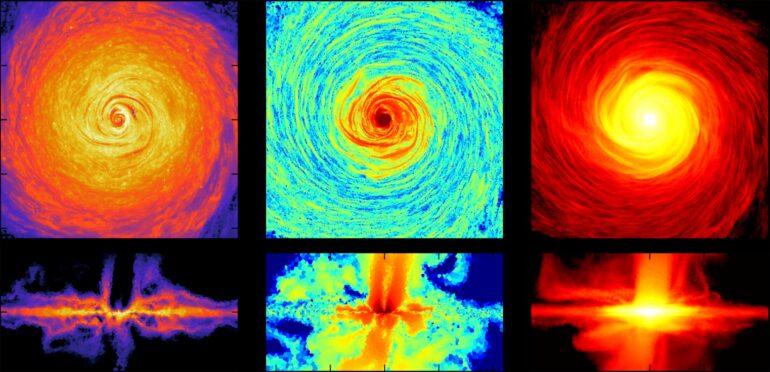On the 50th anniversary of the discovery of a close connection between star formation in galaxies and their infrared and radio radiation, researchers at the Leibniz Institute for Astrophysics Potsdam (AIP) have now deciphered the underlying physics. To this end, they used novel computer simulations of galaxy formation with a complete modeling of cosmic rays.
To understand the formation and evolution of galaxies like our Milky Way, it is of particular importance to know the amount of newly formed stars in both nearby and distant galaxies. For this purpose, astronomers often use a link between the infrared and radio radiation of galaxies, which has already been discovered 50 years ago: the energetic radiation of young, massive stars that form in the densest regions of galaxies is absorbed by surrounding dust clouds and re-emitted as low-energy infrared radiation. Eventually, when their fuel supply is exhausted, these massive stars explode as supernovae at the end of their lives. In this explosion, the outer stellar envelope is ejected into the environment, which accelerates a few particles of the interstellar medium to very high energies, giving rise to so-called cosmic rays. In the galaxy’s magnetic field, these fast particles, traveling at nearly the speed of light, emit very low-energy radio radiation with a wavelength of a few centimeters to meters. Through this chain of processes, newly-forming stars, infrared radiation and radio radiation from galaxies are closely linked.
Although this relation is often used in astronomy, the exact physical conditions are not yet clear. Previous attempts to explain it usually failed in one prediction: if high-energy cosmic rays are indeed responsible for the radio radiation of these galaxies, the theory predicts very steep radio spectra—high emission at low radio frequencies—that do not match observations. To get to the bottom of this mystery, a team of researchers at AIP has now, for the first time, realistically simulated these processes of a forming galaxy on a computer and calculated the cosmic ray energy spectra. Their results are published in Monthly Notices of the Royal Astronomical Society.
“During the formation of the galactic disk, cosmic magnetic fields are amplified so that they match the strong observed galactic magnetic fields,” explains Professor Christoph Pfrommer, head of the section Cosmology and High-Energy Astrophysics at AIP. When cosmic ray particles in magnetic fields emit radio radiation, it loses part of its energy on its way to us. As a result, the radio spectrum becomes flatter at low frequencies. At high frequencies, in addition to the radio emission of cosmic rays, the radio emission of the interstellar medium, which has a flatter spectrum, also contributes. The sum of these two processes can therefore perfectly explain the observed flat radio radiation of the whole galaxy as well as the emission of the central regions.
This also explains the mystery of why the infrared and radio radiation of galaxies are so well linked. “This allows us to better determine the number of newly formed stars from the observed radio emission in galaxies, which will help us to further unravel the story of star formation in the universe,” concludes Maria Werhahn, Ph.D. student at AIP and first author of one of the studies.
More information:
Maria Werhahn et al, Cosmic rays and non-thermal emission in simulated galaxies—III. Probing cosmic-ray calorimetry with radio spectra and the FIR–radio correlation, Monthly Notices of the Royal Astronomical Society (2021). DOI: 10.1093/mnras/stab2535
Christoph Pfrommer, Maria Werhahn, Rüdiger Pakmor, Philipp Girichidis, Christine M. Simpson, Simulating radio synchrotron emission in star-forming galaxies: small-scale magnetic dynamo and the origin of the far infrared-radio correlation. arXiv:2105.12132v2 [astro-ph.GA], arxiv.org/abs/2105.12132v2
Provided by
Leibniz Institute for Astrophysics Potsdam
Citation:
The puzzling link between star formation and radio emission in galaxies (2022, June 29)



